Product and Services
- Get Started
- Service Management
- Overview
- Incident Management
- Incident Lifecycle
- State & Status
- Key Processes
- Test Cases
- FAQs
- Inventory Management
- Change Management
- SR/CR Lifecycle
- State & Status
- Additional Resources
- Co Management
- SD-WAN Policy Management
- Dynamic Bandwidth
- Overview
- Benefits
- Additional Resources
- Secure Cloud Interconnect
- Overview
- Billing Usage
- Bandwidth
- Standardized APIs
- Ethernet Services APIs
- Internet Dedicated APIs
- -
Getting started
1) Understand APIs
The Explore section also has the "API documentation" link which provides details on the API request/response parameters,sample requests and URLs.
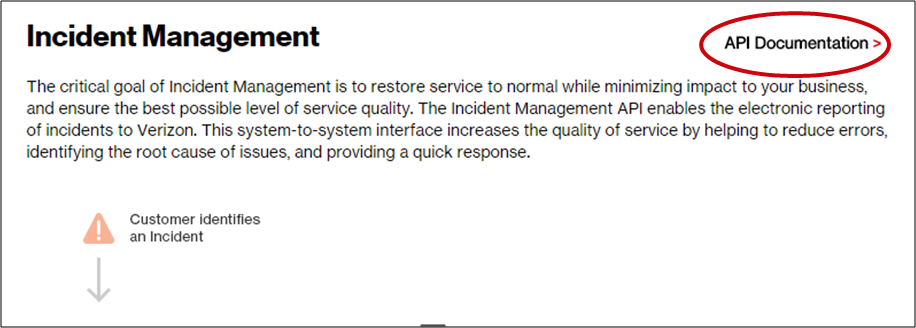
2) Register
Developers can register to the site by clicking on the "Register" button on the screen. After registration the user will have to be approved by Verizon to gain access to site.

A logged in user also has access to test APIs on the web site. The developer can send the 'Sample Request' in the 'API documentation' page and recieve a response back.

3) Request credentials for 'Test' environment.
All the Verizon API resources are protected using 2 Way SSL + Basic Auth.
Once logged into the site , go to the "Develop" section and click on the "New Subscription". The developer can only subscribe to APIs in the test environment.
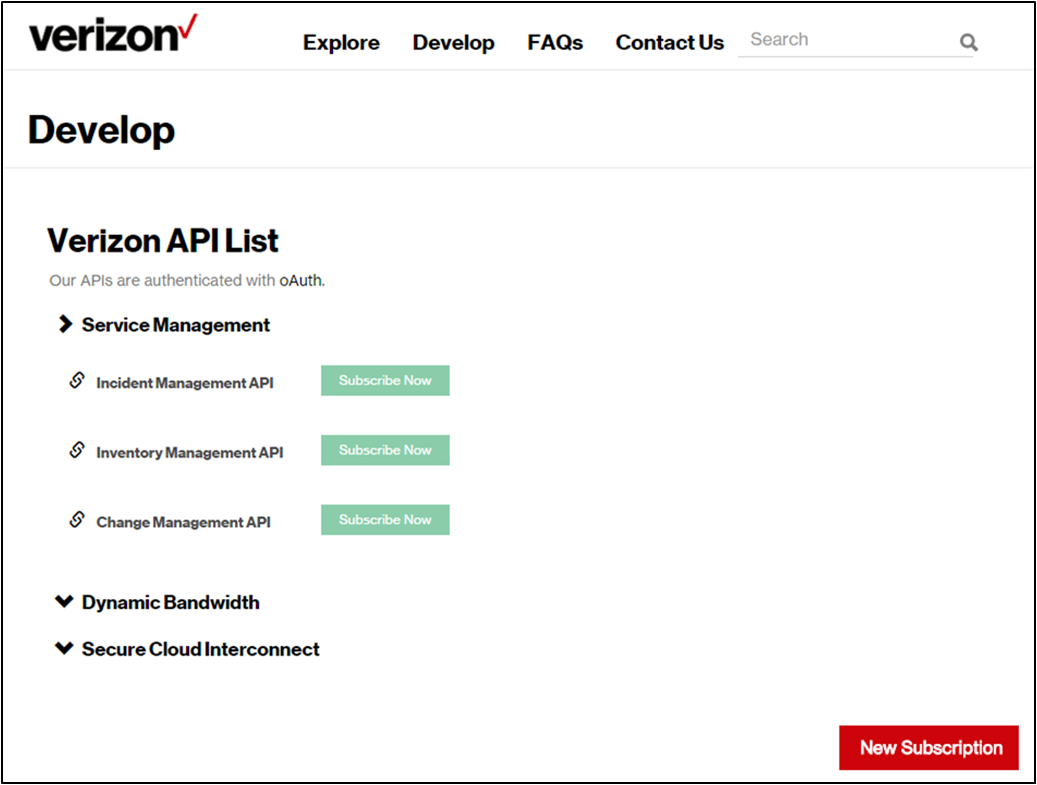
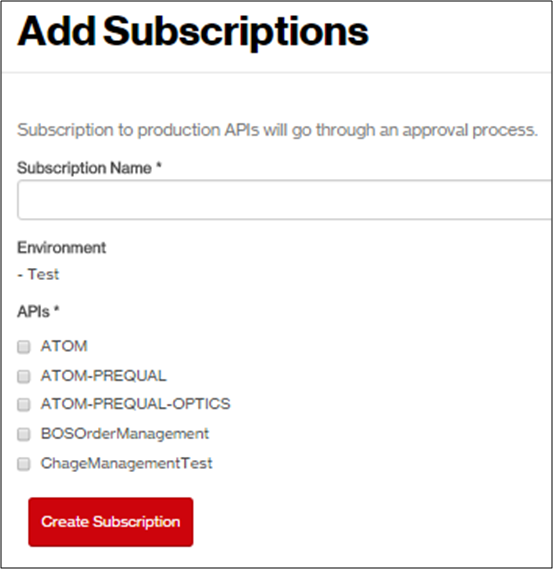
Subscriptions to APIs in test environment are auto approved. When a developer subscribes to an API , they are provided with the client id / secret required to invoke the API resources.
4) Onboard Company Admin
A company admin is a CPNI (Customer Proprietary Network Information) authorized contact for the customer's account. Only the identified Company Admin users will have access to request/obtain the production credentials. All other users (also identified as developers) can only obtain credentials for the test environment.
Company Admin users can be onboarded by the Verizon Account team only. Please contact your account team to identify and onboard a company admin.
5) Request credentials for 'Production' environment.
The company admin can now login and subscribe to APIs in the production environment.
All production subscriptions needs to be approved by Verizon.
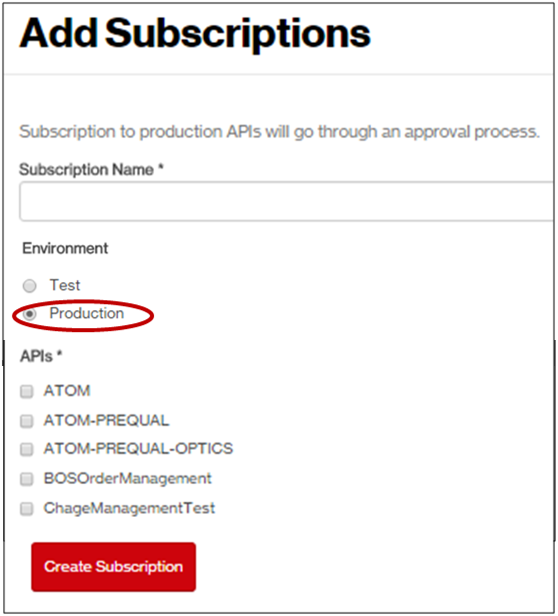
Learn about Service Management
What is Service Management?
Service Management, refers to a B2B software interface which automates the data exchange between two business applications. Changes in transactional data in one system are reflected in the other system essentially "bonding" the two sets of data. The benefits of Service Management include increased efficiency, greater effectiveness, and improved customer experience.

What does Verizon offer?
Verizon empowers customers with the ability to set up a personalized Service Management interface. With resources such as technical assistance provided by Verizon, the portal greatly simplifies Service Management for users who are new to the process.
Incident Management
The critical goal of Incident Management is to restore service to normal while minimizing impact to your business, and ensure the best possible level of service quality. The Incident Management API enables the electronic reporting of incidents to Verizon. This system-to-system interface increases the quality of service by helping to reduce errors, identifying the root cause of issues, and providing a quick response.

Reactive Tickets
This flow represents the manual process whereby an incident is identified and reported by a customer.
Proactive Tickets
A proactive ticket is one which is automatically created via Service Management according to an alarm generated by Verizon's monitoring application.
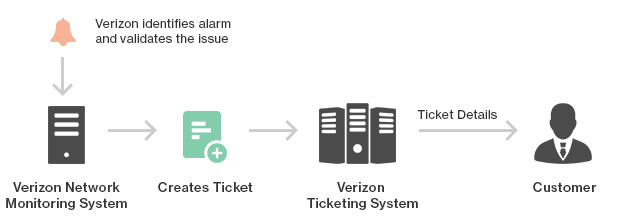
Incident Lifecycle
The lifecycle of an incident starts with ticket creation. Verizon’s Incident Management API enables electronic incident submission and retrieval for ticket creation and serves as the information exchange medium for updating and retrieval of the latest activity logs. Additionally, a list of all tickets and the corresponding status is readily available.

Create Ticket
This operation allows ITIL ticket creation requests to be submitted. This operation is invoked by the customer too create a new trouble ticket. Verizon returns the ticket # upon successful submission of ticket request or will return an error.

Update Ticket
Update Ticket has 7 different actions which can be taken by the customer and electronically documented in Verizon’s system.
Cross Reference Ticket
Send the customer ticket number to set up a cross-reference on an open Verizon ticket. Note that this activity is required.
Add Comment
Send a comment to a Verizon ticket.
Request Escalation
Request an escalation of the ticket. Request escalation of a ticket.* *Note: The priority of a ticket will not change, but additional attention will be paid to the issue.
Add Attachment
Send attachment(s) to a Verizon ticket. Acceptable types of formats: .txt, .doc, .xls, .pdf, .jpg, .docx, .xlsx
Request Close/Cancel
Request that an open ticket be closed or cancelled.
Reopen
Request that a resolved ticket be reopened if the issue is still present.
Request Close Fix Verified
Request that the customer verify the fix is working. If a confirmation is not received in 24 hours, the ticket will be automatically closed or according to the contractual agreement's time frame.

Get Ticket List
The GetTicketListService returns the lists of tickets created or updated during the timeframe (fromDate and toDate) sent in the request. More information as follows:
- This function can be scheduled to run every 15 or 30 mins to receive new tickets created by Verizon or updates to existing ticket.
- Schedule the GetTicketListService call every 15 or 30 mins with the “fromDate” set to the last time a successful response was received from Verizon (this will ensure no updates are missed).
- The “toDate” field is optional and will default to the current time if not set.
- The GetTicketListResponse only returns metadata of the Verizon tickets updated/created.
- To get more detailed information on the ticket, call the GetTicketService for each ticket returned in the GetTicketListService.

Get Ticket
The GetTicketService returns detailed information for a particular ticket and the activities performed on the ticket. Call the GetTicketService for each of the tickets received in the GetTicketListService.
State & Status Details
State and status combinations are used to communicate the current condition of a ticket. The table below provides an incident lifecycle flow broken down by high level ticket states and detailed definitions for each of the status abbreviations which correspond to the states. For each state, there are at least two possible statuses.
| State | Status | ||||||||
|---|---|---|---|---|---|---|---|---|---|
| Open |
|
||||||||
| Resolved |
|
||||||||
| Deferred |
|
||||||||
| Closed |
|
Key Processes
Key Processes are those system steps required to move through the incident lifecycle successfully. Verizon has outlined the Key Process steps and our corresponding best practice which is vital to success.
| Process Issue | Best Practice |
|---|---|
| Tight Integration vs. Loosely Coupled Integration between the Service Management Tickets | Plan on a loosely coupled integration so that both systems can manage their workflow independent of each other. |
| Reopening of Tickets | Reopening is only applicable to Tickets in RESOLVED state. If CLOSED, new Ticket needs to be opened. |
| Ticket Resolution/ Closure Process | VZ will always send the RESOLVE Activity beforehand. Customer will verify resolution and send back confirmation to close or reopen. |
| Escalation of Tickets | Include the ability to send request for escalation. Escalation is not automatic. A comment is added to VZ Ticket and VZ NOC escalates after review. |
| SLA Implications | Don’t change the current SLAs. If VZ Ticket is put on Customer Time, a publishActivity will be sent by VZ. |
| Mechanism to wait for Service Management transaction to complete before further action is taken on the ticket | Implement ability to prevent the customer user from sending updates to VZ before Service Management round trip is complete. |
| Duplicate Tickets | Both parties should agree on the pair of duplicate tickets and close those on both systems. |
| Erroneous Tickets (Misdirected or Opened by mistake) | Include the option to send a request to cancel a ticket. |
| Connectivity Health Check Process | Implement a test connection process to perform periodic health checks. |
| Inventory Sync-Up | VZ requires that VZ Identifier be used for identifying the product/service for which Ticket is initiated by Customer. This may require Customer to load/sync VZ inventory in their application. |
| Verizon changes priority of an incident | Update priority in customer's application or make note of the change. |
| Sequencing of messages | If using the publishing option, it is possible messages could be received out of sequence. Use the sequence number provided in the publish activity to arrange messages in the correct order. |
Test Cases
TEST CASE 1
-
STEP 1 -Do a getTicketList with transaction Id as "TESTCASE1".
-
STEP 2 -Do a getTicket with transaction Id as "TESTCASE1" and verizon ticket number from getTicketListResponse in Step 1.Verify the state="OPEN" and status ="OPEN TO WORKED"
-
STEP 3 -Do a getTicket on the same ticket with transaction Id as "TESTCASE1" and verify the state="OPEN" and status ="WORKING"
-
STEP 4 -Do a getTicket on the same ticket with transaction Id as "TESTCASE1" and verify the state="RESOLVED" and status ="RESOLVED"
-
STEP 5 -Do a getTicket on the same ticket with transaction Id as "TESTCASE1" and verify the state="CLOSED" and status ="CLOSED"
TEST CASE 2
-
STEP 1 -Do a getTicketList with transaction Id as "TESTCASE2".
-
STEP 2 -Do a getTicket with transaction Id as "TESTCASE2" and verizon ticket number from getTicketListResponse in Step 1.Verify the state="OPEN" and status ="OPEN TO WORKED"
-
STEP 3 -Do a getTicket on the same ticket with transaction Id as "TESTCASE2" and verify the state="OPEN" and status ="WORKING"
-
STEP 4 -Do a getTicket on the same ticket with transaction Id as "TESTCASE2" and verify the state="RESOLVED" and status ="AUTO CLOSE"
TEST CASE 3
-
STEP 1 -Do a getTicketList with transaction Id as "TESTCASE3".
-
STEP 2 -Do a getTicket with transaction Id as "TESTCASE3" and verizon ticket number from getTicketListResponse in Step 1.Verify the state="OPEN" and status ="OPEN TO WORKED"
-
STEP 3 -Do a getTicket on the same ticket with transaction Id as "TESTCASE3" and verify the state="OPEN" and status ="WORKING"
-
STEP 4 -Do a getTicket on the same ticket with transaction Id as "TESTCASE3" and verify the state="RESOLVED" and status ="RESOLVED"
-
STEP 5 -Do a getTicket on the same ticket with transaction Id as "TESTCASE3" and verify the state="CLOSED" and status ="VOID"
TEST CASE 4
-
STEP 1 -Do a getTicketList with transaction Id as "TESTCASE4".
-
STEP 2 -Do a getTicket with transaction Id as "TESTCASE4" and verizon ticket number from getTicketListResponse in Step 1.Verify the state="OPEN" and status ="OPEN TO WORKED"
-
STEP 3 -Do a getTicket on the same ticket with transaction Id as "TESTCASE4" and verify the state="OPEN" and status ="WORKING"
-
STEP 4 -Do a getTicket on the same ticket with transaction Id as "TESTCASE4" and verify the state="RESOLVED" and status ="AUTO CLOSE"
TEST CASE 5
-
STEP 1 -Send a createTicket with transaction Id as "TESTCASE5".
-
STEP 2 -Do a getTicket with transaction Id as "TESTCASE5" and verizon ticket number from getTicketListResponse in Step 1.Verify the state="OPEN" and status ="OPEN TO WORKED"
-
STEP 3 -Do a getTicket on the same ticket with transaction Id as "TESTCASE5" and verify the state="OPEN" and status ="WORKING"
-
STEP 4 -Do a getTicket on the same ticket with transaction Id as "TESTCASE5" and verify the state="RESOLVED" and status ="RESOLVED"
-
STEP 5 -Do a getTicket on the same ticket with transaction Id as "TESTCASE5" and verify the state="CLOSED" and status ="CLOSED"
TEST CASE 6
-
STEP 1 -Send a createTicket with transaction Id as "TESTCASE6".
-
STEP 2 -Do a getTicket with transaction Id as "TESTCASE6" and verizon ticket number from getTicketListResponse in Step 1.Verify the state="OPEN" and status ="OPEN TO WORKED"
-
STEP 3 -Do a getTicket on the same ticket with transaction Id as "TESTCASE6" and verify the state="OPEN" and status ="WORKING"
-
STEP 4 -Do a getTicket on the same ticket with transaction Id as "TESTCASE6" and verify the state="RESOLVED" and status ="RESOLVED"
-
STEP 5 -Do a getTicket on the same ticket with transaction Id as "TESTCASE6" and verify the state="CLOSED" and status ="VOID"
TEST CASE 7
-
STEP 1 -Send a createTicket with transaction Id as "TESTCASE7".
-
STEP 2 -Do a getTicket with transaction Id as "TESTCASE7" and verizon ticket number from getTicketListResponse in Step 1.Verify the state="OPEN" and status ="OPEN TO WORKED"
-
STEP 3 -Do a getTicket on the same ticket with transaction Id as "TESTCASE7" and verify the state="OPEN" and status ="WORKING"
-
STEP 4 -Do a getTicket on the same ticket with transaction Id as "TESTCASE7" and verify the state="RESOLVED" and status ="RESOLVED"
-
STEP 5 -Do a getTicket on the same ticket with transaction Id as "TESTCASE7" and verify the state="CLOSED" and status ="CLOSED"
TEST CASE 8
-
STEP 1 -Send a createTicket with transaction Id as "TESTCASE8".
-
STEP 2 -Do a getTicket with transaction Id as "TESTCASE8" and verizon ticket number from getTicketListResponse in Step 1.Verify the state="OPEN" and status ="OPEN TO WORKED"
-
STEP 3 -Do a getTicket on the same ticket with transaction Id as "TESTCASE8" and verify the state="OPEN" and status ="WORKING"
-
STEP 4 -Do a getTicket on the same ticket with transaction Id as "TESTCASE8" and verify the state="RESOLVED" and status ="AUTO CLOSE"
TEST CASE 9
-
STEP 1 -Send a createTicket with transaction Id as "TESTCASE9".
-
STEP 2 -Do a getTicket with transaction Id as "TESTCASE9" and verizon ticket number from getTicketListResponse in Step 1.Verify the state="OPEN" and status ="OPEN TO WORKED"
-
STEP 3 -Do a getTicket on the same ticket with transaction Id as "TESTCASE9" and verify the state="OPEN" and status ="WORKING"
-
STEP 4 -Do a getTicket on the same ticket with transaction Id as "TESTCASE9" and verify the state="RESOLVED" and status ="MSVC AUTO CLOSE"
10. Proactive or reactive ticket, ticket is resolved by Verizon, customer submits request close fix verify activity, ticket is closed by Verizon
- Open, to be worked
- Open, working
- Resolved, resolved
- Closed, closed
11. Proactive or reactive ticket, ticket is escalated by customer, resolve auto close
- Open, to be worked
- Open, working
- Resolved, auto close
12. Proactive or reactive ticket, ticket is moved to customer time, customer sends comment, ticket is released from customer time, resolve auto close.
- Open, to be worked
- Open, working
- Deferred, cust time
- Open, to be worked
- Resolved, auto close
13. Proactive or reactive ticket, ticket is moved to monitor service, ticket is released from monitor service, resolve auto close
- Open, to be worked
- Open, working
- Deferred, monitor sv
- Open, to be worked
- Resolve, auto close
14. Proactive or reactive ticket, ticket is moved to maintenance time, ticket is released from maintenance time, resolve auto close
- Open, to be worked
- Open, working
- Deferred, maint ops
- Open, to be worked
- Resolve, auto close
15. Proactive or reactive ticket, ticket is moved to customer impacting maintenance time, ticket is released from maintenance time, resolve auto close
- Open, to be worked
- Open, working
- Deferred, maint cus
- Open, to be worked
- Resolve, auto close
16. Proactive or reactive ticket, ticket is resolved by Verizon, customer requests to reopen the ticket, ticket is reopened automatically
- Open, to be worked
- Open, working
- Resolved, resolved
- Open, to be worked
17. Proactive or reactive ticket, ticket is resolved by Verizon, Verizon reopen the ticket, ticket is reopened automatically
- Open, to be worked
- Open, working
- Resolved, resolved
- Open, to be worked
Frequently asked Questions and Answers

How will a priority change in my application impact the Verizon priority?
The functionality of the Verizon ticketing system does not allow for the priority to be changed.

Are duplicate tickets for the same issues allowed by Verizon on higher priority tickets?
No, you may receive an error in trying to submit a ticket for an issue which Verizon has already opened a ticket on.

What does the request escalation activity trigger on the Verizon side?
Escalation can be requested, but it doesn't result in a priority change, though there is greater visibility on the ticket.

How will Verizon respond to a ticket that does not have the correct ServiceID or CI?
The ticket would be opened as a non-validated ticket, which will require triage to find the correct service identifier before operations can start working on a resolution.
Inventory Management
A configuration management database (CMDB) is a data warehouse of all customer assets. It contains assets commonly known as configuration items (CI). The Verizon inventory service provides configuration items required by the incident management API. Once the inventory data is received, it can be loaded into the customer’s CMDB and made available for users when submitting incidents. Incidents submitted to Verizon require a valid Verizon service ID, also known as a CI.
The inventory service offers two API operations, CI List and CI Detail.
CI List
This service provides a list of all available configuration items for a given user account. The list can be pulled using a REST POST call. The REST call results in a response based on the users request and the various parameters provided. Header fields like login ID and user ID values are required in order to display the user’s transaction. For the request, transaction ID and version are the only required fields for this activity, all other fields are optional.
CI List daily delta report – This report provides a daily delta report controlled by the “period” filter ranging from 1-31 days. Day 1 represents T-1 or the previous day. This report can be run once daily to pull yesterday’s changes. Days representing period=2 to 31 may be run only when needed.
CI List full inventory report – This API provides the full inventory for supported products. Please note that a full inventory is an exhaustive list and should be used for initial database population or on a quarterly basis for reconciliation. The response is paginated if more than 5000 records are found. The ‘nextKey’ filter may be used to pull different pages of the report with each response containing 5000 records.
CI Detail
This service provides detailed information for a particular configuration item. This activity requires only the header fields, transaction ID and CI value (full Verizon configuration item name, such as a DNS entity name, circuit ID, etc.).
Verizon Change Service
The Verizon REST interface supports service (SR) and change request (CR) activities defined as noted below.
Service Request – Requests with no impact to configuration items. Generally these are simple pre-approved work items.
Change Request – Requests involving simple to complex changes impacting configuration items. They may or may not require approvals and could be billable. Verizon supports Standard, Normal, Emergency and Complex workflows.
An SR or CR is identified based on the submitted catalogue request. The catalogue contains three values: the category, type and item (CTI).
Category – Generally a Product/Service Group, such as Managed Network.
Type – Specific product or service within the Category such as Managed LAN, Managed WAN, etc.
Item – Refers to the specific action to be performed.
Verizon offers a standard managed service catalogue listing all of the available CTI values. An example of a valid CTI combination is shown below.
Category – Managed Network.
Type – Managed LAN.
Item – Add/Delete LAN Port Monitoring.
SR/CR Lifecycle
Verizon supports the following operations specific to the SR/CR interface.

Create Ticket
Creates a new SR/CR.

Update Ticket
Used for sending a variety of updates to the request, including the list of possible transaction types below.
crossReference
Submitted in response to a Verizon proactive request. Used to provide the customer request number to Verizon.
addComments
Submit comments to Verizon for a specific SR/CR.
RequestCancel
Submit a request to cancel an existing SR/CR.
RequestClose
Submit a request to close an existing SR/CR.
RequestSuspend
Submit to request that an existing SR/CR be placed on hold.
RequestResume
Submit to request that an SR/CR that was on hold be released from hold status.
RequestRework
Submit to request a SR/CR to be reworked.
ApproveRequest
Submit an approval to Verizon.
addAttachments
Submit an attachment to Verizon for a specific SR/CR.

Get Ticket List
The GetTicketListService returns the lists of tickets created or updated during the timeframe (fromDate and toDate) sent in the request. More information as follows:
- This function can be scheduled to run every 15 or 30 mins to receive new tickets created by Verizon or updates to existing ticket.
- Schedule the GetTicketListService call every 15 or 30 mins with the “fromDate” set to the last time a successful response was received from Verizon (this will ensure no updates are missed).
- The “toDate” field is optional and will default to the current time if not set.
- The GetTicketListResponse only returns metadata of the Verizon tickets updated/created.
- To get more detailed information on the ticket, call the GetTicketService for each ticket returned in the GetTicketListService.

Get Ticket
The GetTicketService returns detailed information for a particular ticket and the activities performed on the ticket. Call the GetTicketService for each of the tickets received in the GetTicketListService.

Get Attachment
The GetAttachmentService returns the content of the attachment file.
The GetTicketService returns the attachment id when an attachment is added to a CR/SR.
The attachment id returned on the GetTicketService response should be passed as an input parameter to this service.
Standard State-Status Transitions
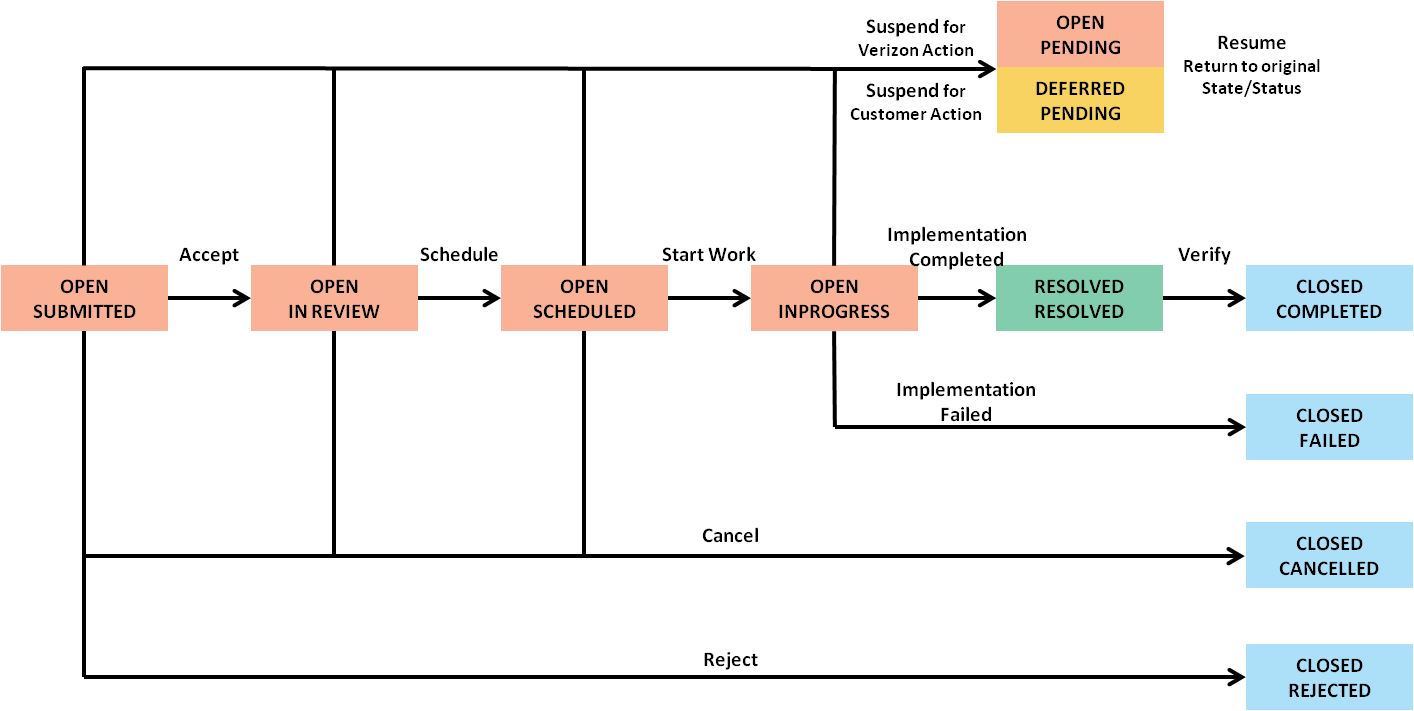
State & Status Combinations for a Standard Change Request
| State | Status | ||||||||||
|---|---|---|---|---|---|---|---|---|---|---|---|
| Open |
|
||||||||||
| Deferred |
|
||||||||||
| Resolved |
|
||||||||||
| Closed |
|
Additional Resources
The Verizon Service Management API uses standard country and error codes which your application must match to ensure a successful eBond. The country and error codes are in the files below which can be downloaded in CSV format.
Countries
The list contains country names and codes.
Errors List
Review the list of errors with their associated codes and messages.
Incident Management Data Mapping
The data mapping for Incident Management services
Change Management Data Mapping
The data mapping for Change Management services
Inventory Management Data Mapping
The data mapping for Inventory Management services
SD-WAN Policy Management
Verizon Policy Management REST interface supports create, update and delete of policies, related objects and profiles.
Application Aware Routing (AAR) Policy:
Customer can establish policies that classify its traffic into categories to the granularity of applications, and define minimal requirements for loss, delay, and jitter per traffic class.
Quality of Service (QoS) Policy:
With QoS, customer has the ability to define parameters to prioritize handling of different types of business data.
The Policy Management service offers the following API operations.
- Get Policy – get details of policies that are deployed in your network
- Manage Policy, Policy Objects, Profiles – Create, Update, Clone or Delete AAR, QoS Policies, policy objects like Applications, Addresses, profiles including SLA, QoS profiles
- Manage Label – Create, Update or Delete Application and User Labels, associate or dissociate policy objects to labels
- Restore Policy – Restore policy to previous versions
Note - We recommend that you test the policy changes soon after you have initiated through APIs and successfully deployed.
Overview
Gain complete control over network orchestration using an API
Seamless networks are crucial to the success of today’s enterprises. To remain ahead of the curve, enterprises are required to perform accelerated and accurate orchestration of their networks that can adapt to changing business needs.
Discover how Verizon’s API-fication – a new revolutionary Application Program Interface (API) solution – can help enterprises achieve accelerated network orchestration in real-time and aid in bolstering their network & business performance cost-efficiently, by automating a self- service portal that is already up and running.
The new innovative network provisioning API solution can be deployed in the enterprises’ network eco-system to drive real-time network adjustments according to their changing business needs. Taking an agile approach to network provisioning, it can aid in dynamically allocating/de-allocating and scaling the bandwidth requirements as the need arises.
Complementing the Verizon Dynamic Network Manager self-service Web portal, this API solution empowers enterprises with on-premise auto-provisioning capability by rendering seamless Machine-to-Machine (M2M) communication. And due to the automation involved, the API eliminates all the manual processes required to auto-provision the bandwidth.
With Dynamic Network Manager, enterprises can only view their bandwidth utilization and gauge whether they need to increase or decrease current bandwidth allocations. But with Verizon’s new tailor-made API, enterprises can tune their bandwidth allocations on-premises – with just a click of a button.
Best of all, the API facilitates enterprises to purchase appropriate bandwidth shared across multiple services with standard voice, video, and the Internet Quality of Services (QoS) offerings without keying in manual configurations in the self-service portal.

Verizon APIs Creates an Interface to Help Enterprises’ Systems Communicate with Verizon Network
Benefits
Deployment of Verizon’s new API can potentially result in significant cost savings and business performance. Some of the key benefits include:
Empowering the Enterprises with On-Premise Elastic Bandwidth Management Tool:
Verizon’s API brings in more flexibility into bandwidth provisioning and improves network bandwidth utilization, thereby eliminating the need to buy surplus bandwidth. Moreover, it empowers enterprises with the ability to orchestrate their current as well as future bandwidth allocations, on-premise, as and when required without logging into service provider’s portal. In addition, the API can work in tandem with other applications running on enterprises’ systems to extend or augment the capability or functionality of the network systems. Following are the few scenarios that support this fact:
- It can integrate with an enterprise’s decision-making systems, which may or may not be powered by predictive analytics engine, to intuitively auto-provision the bandwidth
- It can integrate with an enterprise’s network-traffic detecting systems to intuitively set the appropriate QoS
Reduced Opex and Capex:
Since bandwidth provisioning is automated, enterprise customers need not buy unnecessary bandwidth and allocate additional resources. This not only reduces capital expenditure (Capex) but also reduces operational expenditure (Opex) spent on maintaining and operating the network systems. Additionally, the API reduces the cost of managing and designing distributed networks through better standardization and greater efficiency, thereby reducing network lifecycle costs too.
Enhanced Customer Experience:
Due to the automated process offered by the new API, enterprise customers can enhance the overall experience in terms of resource management, cost-efficiency, and time management.
Improved Network Agility:
Verizon’s API drives business agility with adaptable network management capabilities. It also enables network engineers to quickly and easily apply configuration changes according to business needs, at scale, by detecting the type of network traffic. This ultimately boosts network agility.
Capitalize on Verizon’s API-fication of Self Service
Save Time & Resources:

Automatically update status and attributes of an enterprise network with the API, to improve bandwidth utilization. This in turn saves time and resources considerably.
Experience Greater Accuracy:

The API generates information from the in-house enterprise system. This not only eliminates errors but also takes a huge load off the network team.
Avoid Over-Provisioning:

Benefit from continuous monitoring and elastic bandwidth management, and avoid over- provisioning with the API.
Additional Resources
Brochure
Bandwidth services brochure.
Overview
Connect securely and reliably to your cloud.
To amp up your cloud’s performance, you shouldn’t have to send your data and apps over unsecured public or expensive, fixed-bandwidth connections. Our Secure Cloud Interconnect solution offers the high-performing connections of our Private IP Multiprotocol Label Switching (MPLS) or Ethernet networks to securely link you to cloud service providers (CSPs) around the globe. With software defined networking (SDN) and better ways to manage your workload resources, Secure Cloud Interconnect can help you quickly connect to cloud applications for better agility. Combined with the reliability, speed and diversity of our networks, Secure Cloud Interconnect can help make your cloud-based applications more responsive to your business demands. You can also add Secure Cloud Interconnect to other network services for a reliable, integrated solution customized to your needs.
Protect cloud app connections around the globe.
Product highlights
Our Secure Cloud Interconnect solution can help you:
- Control access to critical data by keeping privileges private and secure.
- Connect quickly to CSPs with pre-provisioned, high-speed virtual connections.
- Predict and manage costs with usage-based billing.
- Keep applications available with reliable connectivity.
- Manage network bandwidth and cloud environments online through Verizon Enterprise Center.
Enhance your agility
Secure Cloud Interconnect is now available with Virtual Network Services (VNS), which is a comprehensive suite of network resources that supports virtual functions built on Verizon’s Hosted Network Services platform. Both VNS and Secure Cloud Interconnect are key components of our Software Defined Networking strategy--offering greater flexibility, visibility and control over your network.
- Virtual Network Services—Security, available with Palo Alto and Fortinet, provides additional protection for Secure Cloud Interconnect customer networks from threats with a shared cloud platform.
Note: This is currently limited to Virtual Private Cloud (VPC) Secure Cloud Interconnect customers.
Billing Usage API
The Billing Usage API enables you to view the traffic upon which your invoice is based directly from your own portal without having to log into the Verizon Enterprise Center. With this API, you can see the total gigabytes of data which are passed over a Secure Cloud Interconnect connection for a specified date range. Both ingress and egress traffic can be viewed. You are able to specify the traffic which you would like to see by providing the Billing Account Number (BAN) ID, month, and year. You have the option to enter a start date and end date in the month. The start and end dates are restricted to the 30/31 days in the month selected. If a start and end date are not provided, the data will be automatically pulled for the entire month. You will see usage detail for each Service ID under that BAN.
Utilization API
The Utilization API enables you to view peak utilization and through-put on Secure Cloud Interconnect connections directly from your own portal without having to log into the Verizon Enterprise Center. This data could be utilized to identify applications driving peak traffic and monitor the actual spikes in traffic. The data will be published in megabits per second of data which are passed over a Secure Cloud Interconnect connection at 15 minute intervals. Both ingress and egress traffic can be viewed, and the data is refreshed every hour. You are required to provide the Billing Account Number (BAN) ID. You have the option to enter a start date and end date in the month. The start and end dates are restricted to the 30/31 days in the month selected. If a start and end date are not provided, the data will be automatically pulled for the entire month. You will see usage detail for each Service ID under that BAN for the specified date range.
Ethernet Switched E-Line API Overview
Gain complete control over network orchestration using an API Seamless networks are crucial to the success of today’s enterprises. To remain ahead of the curve, enterprises are required to perform accelerated and accurate orchestration of their networks that can adapt to changing business needs.
Discover how Verizon’s Switched E-Line Application Program Interfaces (APIs) can help you achieve accelerated network orchestration and aid in bolstering your business efficiency, by providing an automated, self-serve option for obtaining new connections. The new, innovative API solutions can be deployed in the your network ecosystem to drive network adjustments according to your changing business needs.
These Switched E-Line API solutions empower you with on-premise, seamless Machine-to-Machine (M2M) communication. Given the growing need for self-service network modifications, the APIs eliminate manual processes required to assess availability and quote service. Best of all, there is an API to allow you to order additional locations to your network and select the appropriate feature/ functionality across the Switched E-Line Ethernet services.

Benefits
Ethernet Switched E-line offers the following APIs, based on MEF Lifecycle Service Orchestration (LSO) API standards, to existing Verizon Ethernet customers:
- Product Order Qualification (POQ), including Address Validation
- Quoting
- Ordering
These APIs support new Switched E-Line connections.
Features:
Enable Self-Service and Network as a Service (NaaS) : Qualify, quote, and order whenever and wherever you choose, along with customer service, as needed.
Cost Savings: Reduce turnaround time and cost by minimizing service qualification, quote, ordering times.
Speed & Efficiency: Provides an effective means to manage network costs with less overbuilds.
Value Added Services: For 3rd Party players to build value added services such as smart cities, smart health services, and cloud connectivity.
Integration with Customers’ existing Systems: For customers with existing Operations Support Systems (OSS), the APIs enable integration as a machine-to-machine interface with Verizon’s systems.
Verizon empowers our customers with the ability to set up Ethernet Switched E-Line APIs for qualification, quoting, ordering, and order status of in-flight orders
- The Qualification API provide address validation to see if the location has Ethernet Switched E-Line services available.
- The Quote API will provide the quote with the price of the ethernet service based on a specific bandwidth.
- Lastly, you can use the Order API to submit an order and the system will return an estimated delivery date..
With technical assistance provided by Verizon, these APIs greatly simplify the Switched E-Line experience for your users, experienced and new..
Internet Dedicated API Overview
Gain complete control over network orchestration using an API Seamless networks are crucial to the success of today’s enterprises. To remain ahead of the curve, enterprises are required to perform accelerated and accurate orchestration of their networks that can adapt to changing business needs.
Discover how Verizon’s Internet Dedicated Application Program Interfaces (APIs) can help you achieve accelerated network orchestration and aid in bolstering your business efficiency, by providing an automated, self-serve option for obtaining new connections. The new, innovative API solutions can be deployed in the your network ecosystem to drive network adjustments according to your changing business needs.
These Internet Dedicated API solutions empower you with on-premise, seamless Machine-to-Machine (M2M) communication. Given the growing need for self-service network modifications, the APIs eliminate manual processes required to assess availability and quote service. Best of all, there is an API to allow you to order additional locations to your network and select the appropriate feature/ functionality across the Internet Dedicated services.

Verizon empowers our customers with the ability to set up Internet Dedicated APIs for qualification, quoting, ordering, and order status of in-flight orders
- The Qualification API provide address validation to see if the location has Internet Dedicated services available.
- The Quote API will provide the quote with the price of the ethernet service based on a specific bandwidth.
- Lastly, you can use the Order API to submit an order and the system will return an estimated delivery date..
With technical assistance provided by Verizon, these APIs greatly simplify the Intenet Dedicated experience for your users, experienced and new..
Benefits
Internet Dedicated offers the following APIs, based on MEF Lifecycle Service Orchestration (LSO) API standards, to existing Verizon Internet customers:
- Product Order Qualification (POQ), including Address Validation
- Quoting
- Ordering
These APIs support new Intenet Dedicated connections.
Features:
Enable Self-Service and Network as a Service (NaaS) : Qualify, quote, and order whenever and wherever you choose, along with customer service, as needed.
Cost Savings: Reduce turnaround time and cost by minimizing service qualification, quote, ordering times.
Speed & Efficiency: Provides an effective means to manage network costs with less overbuilds.
Value Added Services: For 3rd Party players to build value added services such as smart cities, smart health services, and cloud connectivity.
Integration with Customers’ existing Systems: For customers with existing Operations Support Systems (OSS), the APIs enable integration as a machine-to-machine interface with Verizon’s systems.
Additional resources
Internet Dedicated APIs User Guide
.............
